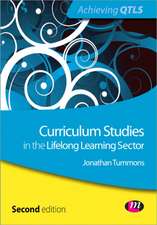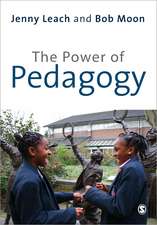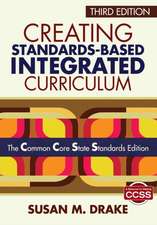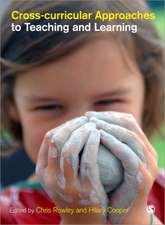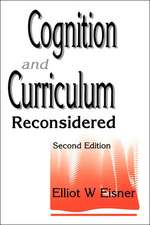The Parallel Curriculum: A Design to Develop Learner Potential and Challenge Advanced Learners
Autor Carol Ann Tomlinson, Sandra N. Kaplan, Joseph S. Renzulli, Jeanne H. Purcell, Jann H. Leppien, Deborah E. Burns, Cindy A. Strickland, Marcia B. Imbeauen Limba Engleză Paperback – 16 dec 2008
| Toate formatele și edițiile | Preț | Express |
|---|---|---|
| Paperback (1) | 203.27 lei 22-36 zile | +38.51 lei 5-11 zile |
| SAGE Publications – 16 dec 2008 | 203.27 lei 22-36 zile | +38.51 lei 5-11 zile |
| Hardback (1) | 648.42 lei 43-57 zile | |
| SAGE Publications – 18 noi 2008 | 648.42 lei 43-57 zile |
Preț: 203.27 lei
Nou
Puncte Express: 305
Preț estimativ în valută:
38.89€ • 40.72$ • 32.18£
38.89€ • 40.72$ • 32.18£
Carte disponibilă
Livrare economică 17-31 martie
Livrare express 28 februarie-06 martie pentru 48.50 lei
Preluare comenzi: 021 569.72.76
Specificații
ISBN-13: 9781412961318
ISBN-10: 1412961319
Pagini: 336
Ilustrații: 1, black & white illustrations
Dimensiuni: 216 x 279 x 20 mm
Greutate: 0.76 kg
Ediția:Second Edition
Editura: SAGE Publications
Colecția Corwin
Locul publicării:Thousand Oaks, United States
ISBN-10: 1412961319
Pagini: 336
Ilustrații: 1, black & white illustrations
Dimensiuni: 216 x 279 x 20 mm
Greutate: 0.76 kg
Ediția:Second Edition
Editura: SAGE Publications
Colecția Corwin
Locul publicării:Thousand Oaks, United States
Recenzii
Praise for the First Edition:
“This thought-provoking, creative, and inspiring book contains chapters by recognized leaders in the field. The authors offer guidelines needed for developing and implementing effective, valuable curriculum for all classrooms.”
"As a principal and instructional leader, I have learned far more about effective instruction and powerful unit and lesson design from the Parallel Curriculum Model than anything else. PCM helps teachers not only strengthen their knowledge and pedagogy, but also rediscover a passion for their discipline based on their deeper, more connected understanding. Our students think critically and deeply at a level I have never before witnessed."
"What makes this book unique is its insistence on the development of conceptual understanding of content and its focus on the abilities, interests, and learning preferences of each student. The Parallel Curriculum Model provides a path for educators to move from novice to expert."
"Offers a sophisticated yet doable model for curriculum planning. The approach honors the integrity of the disciplines while remaining responsive to the diversity of learners that teachers encounter. This book provides a practical pathway for connecting the content and the kids."
“This thought-provoking, creative, and inspiring book contains chapters by recognized leaders in the field. The authors offer guidelines needed for developing and implementing effective, valuable curriculum for all classrooms.”
"As a principal and instructional leader, I have learned far more about effective instruction and powerful unit and lesson design from the Parallel Curriculum Model than anything else. PCM helps teachers not only strengthen their knowledge and pedagogy, but also rediscover a passion for their discipline based on their deeper, more connected understanding. Our students think critically and deeply at a level I have never before witnessed."
"What makes this book unique is its insistence on the development of conceptual understanding of content and its focus on the abilities, interests, and learning preferences of each student. The Parallel Curriculum Model provides a path for educators to move from novice to expert."
"Offers a sophisticated yet doable model for curriculum planning. The approach honors the integrity of the disciplines while remaining responsive to the diversity of learners that teachers encounter. This book provides a practical pathway for connecting the content and the kids."
Cuprins
Preface to the Second Edition
Acknowledgments
About the Authors
1. The Rationale and Guiding Principles for an Evolving Conception of Curriculum
A Word to New Readers About This Chapter
Reasons for Another Curriculum Model
Theoretical and Research-Based Underpinnings of the Parallel Curriculum Model
2. An Overview of the Parallel Curriculum Model
A Look at the Four Curriculum Parallels
The Core Curriculum
The Curriculum of Connections
The Curriculum of Practice
The Curriculum of Identity
Curriculum Combining the Four Parallels
Planning Quality Curriculum
Ensuring Fidelity to the Parallel Curriculum Model
Looking Ahead in the Book
3. Thinking About the Elements of Curriculum Design
The Big Picture
Planning Quality Curriculum
Some Key Components of Curriculum Design
Components of a Comprehensive Curriculum Plan
Content/Standards
Assessment
Introductory Activities
Teaching Methods
Learning Activities
Grouping Strategies
Products
Resources
Extension Activities
Differentiation Based on Learner Need (Including AID)
Lesson and Unit Closure
Remodeling a Unit Using the Comprehensive Curriculum Framework: One Teacher's Approach
Looking Back and Ahead
4. The Core Curriculum Parallel
Why Four Approaches to Curriculum Design? Isn't One Good Enough?
What Is "Core" in the Core Curriculum Parallel?
How Are the Key Curriculum Components Reconfigured to Achieve the Goals of the Core Curriculum Parallel?
Revising the Remaining Curriculum Components to Address the Goals of the Core Curriculum Parallel
Using the Goals of the Core Curriculum Parallel and Key Curricular Elements for Lydia Janis's Civil War Unit
Looking Back and Ahead
5. The Curriculum of Connections Parallel
What Is the Curriculum of Connections?
The Purpose of a Curriculum of Connections: Why Should a Teacher Emphasize Connections and Relationships?
The Curriclum of Connections: When Should I Use This Parallel?
The Characteristics of the Curriculum Components Within the Curriculum of Connections
Reconfiguring Other Curriculum Components for the Curriculum of Connections
An Example of the Curriculum of Connections Using the Civil War Unit
Looking Back and Ahead
6. The Curriculum of Practice Parallel
What Does It Mean to "Practice" in a Curriculum?
Why Does It Matter to Have Students Engage in the Curriculum of Practice?
Key Features of the Components of Curriculum in the Curriculum of Practice?
An Example of the Curriculum of Practice Using Lydia's Civil War Unit
Looking Back and Ahead
7. The Curriculum of Identity Parallel
What Does Identity Mean in the Curriculum of Identity?
Why Should We Be Concerned About a Student's Identity?
What Are the Key Features and Characteristics of Curriculum Components Within the Curriculum of Identity?
An Example of the Curriculum of Identity Using Lydia's Civil War Unit
Looking Back and Ahead
8. Ascending Intellectual Demand in the Parallel Curriculum Model: The Journey Toward Expertise
Ascending Intellectual Demand: The Path to Expertise
Planning Backwards From Expertise
Understanding the AID Continuum
On the Continuum Novice
On the Continuum Apprentice
On the Continuum Practitioner
On the Continuum Expert
Transitions on the AID Continuum
A Model for Planning Student Movement Along the AID Continuum
The Novice in Science
The Apprentice in Science
The Practitioner in Science
The Expert in Science
Planning the Path Toward Expertise in Science
The Novice in Mathematics
The Apprentice in Mathematics
The Practitioner in Mathematics
The Expert in Mathematics
The Novice in History
The Apprentice in History
The Practitioner in History
The Expert in History
The Novice in English and Language Arts
The Apprentice in English and Language Arts
The Practitioner in English and Language Arts
The Expert in English and Language Arts
Using the AID Continuum
Resource A: Teaching Resources for Chapter 8
References
Index
Acknowledgments
About the Authors
1. The Rationale and Guiding Principles for an Evolving Conception of Curriculum
A Word to New Readers About This Chapter
Reasons for Another Curriculum Model
Theoretical and Research-Based Underpinnings of the Parallel Curriculum Model
2. An Overview of the Parallel Curriculum Model
A Look at the Four Curriculum Parallels
The Core Curriculum
The Curriculum of Connections
The Curriculum of Practice
The Curriculum of Identity
Curriculum Combining the Four Parallels
Planning Quality Curriculum
Ensuring Fidelity to the Parallel Curriculum Model
Looking Ahead in the Book
3. Thinking About the Elements of Curriculum Design
The Big Picture
Planning Quality Curriculum
Some Key Components of Curriculum Design
Components of a Comprehensive Curriculum Plan
Content/Standards
Assessment
Introductory Activities
Teaching Methods
Learning Activities
Grouping Strategies
Products
Resources
Extension Activities
Differentiation Based on Learner Need (Including AID)
Lesson and Unit Closure
Remodeling a Unit Using the Comprehensive Curriculum Framework: One Teacher's Approach
Looking Back and Ahead
4. The Core Curriculum Parallel
Why Four Approaches to Curriculum Design? Isn't One Good Enough?
What Is "Core" in the Core Curriculum Parallel?
How Are the Key Curriculum Components Reconfigured to Achieve the Goals of the Core Curriculum Parallel?
Revising the Remaining Curriculum Components to Address the Goals of the Core Curriculum Parallel
Using the Goals of the Core Curriculum Parallel and Key Curricular Elements for Lydia Janis's Civil War Unit
Looking Back and Ahead
5. The Curriculum of Connections Parallel
What Is the Curriculum of Connections?
The Purpose of a Curriculum of Connections: Why Should a Teacher Emphasize Connections and Relationships?
The Curriclum of Connections: When Should I Use This Parallel?
The Characteristics of the Curriculum Components Within the Curriculum of Connections
Reconfiguring Other Curriculum Components for the Curriculum of Connections
An Example of the Curriculum of Connections Using the Civil War Unit
Looking Back and Ahead
6. The Curriculum of Practice Parallel
What Does It Mean to "Practice" in a Curriculum?
Why Does It Matter to Have Students Engage in the Curriculum of Practice?
Key Features of the Components of Curriculum in the Curriculum of Practice?
An Example of the Curriculum of Practice Using Lydia's Civil War Unit
Looking Back and Ahead
7. The Curriculum of Identity Parallel
What Does Identity Mean in the Curriculum of Identity?
Why Should We Be Concerned About a Student's Identity?
What Are the Key Features and Characteristics of Curriculum Components Within the Curriculum of Identity?
An Example of the Curriculum of Identity Using Lydia's Civil War Unit
Looking Back and Ahead
8. Ascending Intellectual Demand in the Parallel Curriculum Model: The Journey Toward Expertise
Ascending Intellectual Demand: The Path to Expertise
Planning Backwards From Expertise
Understanding the AID Continuum
On the Continuum Novice
On the Continuum Apprentice
On the Continuum Practitioner
On the Continuum Expert
Transitions on the AID Continuum
A Model for Planning Student Movement Along the AID Continuum
The Novice in Science
The Apprentice in Science
The Practitioner in Science
The Expert in Science
Planning the Path Toward Expertise in Science
The Novice in Mathematics
The Apprentice in Mathematics
The Practitioner in Mathematics
The Expert in Mathematics
The Novice in History
The Apprentice in History
The Practitioner in History
The Expert in History
The Novice in English and Language Arts
The Apprentice in English and Language Arts
The Practitioner in English and Language Arts
The Expert in English and Language Arts
Using the AID Continuum
Resource A: Teaching Resources for Chapter 8
References
Index
Notă biografică
Carol Ann Tomlinson`s career as an educator includes 21 years as a public school teacher. She taught in high school, preschool, and middle school, and worked with heterogeneous classes as well as special classes for students identified as gifted and students with learning difficulties. Her public school career also included 12 years as a program administrator of special services for advanced and struggling learners. She was Virginiäs Teacher of the Year in 1974. She is professor of educational leadership, foundations, and policy at the University of Virginiäs Curry School of Education; a researcher for the National Research Center on the Gifted and Talented; a codirector of the University of Virginiäs Summer Institute on Academic Diversity; and president of the National Association for Gifted Children. Special interests throughout her career have included curriculum and instruction for advanced learners and struggling learners, effective instruction in heterogeneous settings, and bridging the fields of general education and gifted education. She is author of over 100 articles, book chapters, books, and other professional development materials, including How to Differentiate Instruction in Mixed-Ability Classrooms, The Differentiated Classroom: Responding to the Needs of All Learners, Leadership for Differentiated Schools and Classrooms, the facilitator¿s guide for the video staff development sets called Differentiating Instruction, and At Work in the Differentiated Classroom, as well as a professional inquiry kit on differentiation. She works throughout the United States and abroad with teachers whose goal is to develop more responsive heterogeneous classrooms.
Descriere
Engage students with a rich curriculum that strengthens their capacity as learners and thinkers!
Every learner is somewhere on a path toward expertise in a content area. This resource promotes a model for developing high-quality curriculum that moves learners along the continuum toward expertise and provides sample units and rubrics to help implement differentiated curriculum. Teachers can use four curriculum parallels that incorporate Ascending Intellectual Demand to:
Every learner is somewhere on a path toward expertise in a content area. This resource promotes a model for developing high-quality curriculum that moves learners along the continuum toward expertise and provides sample units and rubrics to help implement differentiated curriculum. Teachers can use four curriculum parallels that incorporate Ascending Intellectual Demand to:
- Determine current student performance levels
- Appropriately challenge all students in each subject area
- Extend the abilities of students who perform at advanced levels
- Provide learning activities that elevate analytical, critical, and creative thinking












